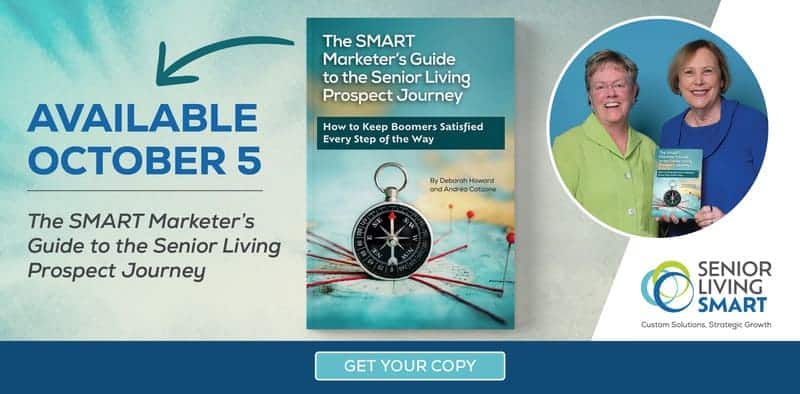Senior Living Marketing Trends: Our Predictions
‘Tis the season for reflecting on the past and making predictions for the future. In the spirit of the latter, we’re sharing four senior living marketing trends that everyone should keep in mind in 2022.
- The pandemic might be winding down, but virtual tours won’t be going away.
Even though we’re quickly approaching two years (!) since the start of the pandemic, this doesn’t mean we’ll be reverting to pre-pandemic ways in all areas of life. Take virtual tours and other virtual tactics that senior living sales folks adopted and adapted to engage with prospects. Even though the virtual tours were originally considered a stop-gap or Band-Aid, a funny thing happened: They worked really well. Senior living sales were still made. And offering virtual tours expanded a community’s reach. (Think of the adult child who lives in a different state than her father.) Necessity is the mother of invention, as they say.
Prediction: Virtual tours and 3D walk-throughs are here to stay.
- Prospects will continue to increase their control over the sales process.
This goes along with the previous point. Sales reps are no longer in control of the sales cycle. Buyers are. That’s why virtual tours won’t be going away—because buyers like having options about how and when to experience a community. The job of the sales and marketing teams is to enable the buyers by providing them with the info they want when they want it—and without an intrusive sales call. Not until the prospect raises their hand and asks for one.
This can be an incredibly hard pill for sales teams to swallow. Sales reps are used to being go-getters. They follow the mantra, “The person who responds first, wins the sale.” But unless the prospect has self-identified that they’re ready for a sales call, you’ll be wasting your time. Today’s buyers are savvy. They know what they want and what they don’t. And what they definitely don’t want is a pushy salesperson.
And sure, while many older adults (think those from the Silent Generation) might not fall into this category, Baby Boomers (many of whom are beginning their journeys into active adult and senior living) DO fall into this category. So at some point, your senior living sales team will need to accept this reality—and adjust its sales tactics accordingly.
Prediction: Buyer enablement will need to be the centerpiece of any successful senior living marketing plan.
- Marketing automation is no longer optional.
OK, so this is part wish, part prediction. Marketing automation is no longer optional if a senior living community wants to achieve its occupancy goals in 2022. Humans can’t effectively manage the multiple touches that today’s prospects require before engaging with sales (see the above point).
That said, we’re also realists. And while we’ve been firmly stating the importance of marketing automation in senior living success, we also know some communities will continue to resist. All we can say is this: Do so at your own peril. You can’t afford to ignore marketing automation any longer.
By the way, marketing automation isn’t as daunting as you might think, especially when you work with an agency like ours that’s got a ton of experience with popular software, like HubSpot for senior living.
Prediction: Communities that haven’t adopted marketing automation will. And those that already have adopted automation will continue to get better at using it.
- Sales cycles will continue to get longer, especially as Boomers start dipping their toes in the senior living/active adult waters.
Older Boomers (those born in 1964) will be turning 58 in 2022. And they are not your grandparents’ retirees. Many of these folks see themselves working well into their sixties and early seventies (by choice or necessity) and even beyond.
Still, they appreciate and crave low-maintenance living now that they’ve raised their families and have done the American Dream of homeownership. They’re thinking about the next chapter in their lives—and what that will look like. They’ll be basing their next move on pleasure, not pain. They won’t be moving into active adult living or senior living due to a physical impairment or some other decline, but rather because they want a better way to live in their sixties and seventies (and beyond).
Prediction: The smartest senior living communities are going to start thinking NOW about how to cater to this audience. Will it involve expanding their own campuses to include another living option, like active adult or 55+? Will it involve redefining what independent living is and perhaps coming up with a hybrid version for people in their mid to late fifties and early sixties?
One thing we DO know: How you market to Boomers will be vastly different from the way you currently market to prospects. Again, younger prospects, like Boomers, are in control of the buying process. They can take time—A LOT of time—deciding on this next step. Some studies suggest you’ll need to have anywhere from 22-28 touches before the prospect is fully engaged with you. And touch #28 needs to be just as engaging as touch #1. No easy task.
What senior living marketing trends are you seeing/hearing about?
Share your thoughts with us in the comments below or on social media. And, as always, if you need help talking through new strategies or senior living marketing plans, give us a shout!





